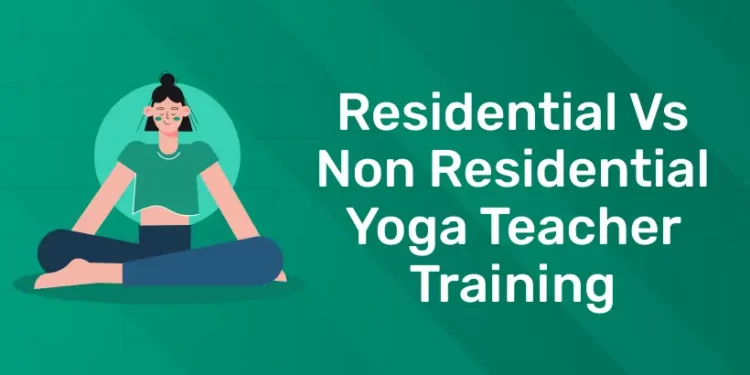Table of Contents
There are several ways to pursue a career as a yoga instructor. When you make learning yoga your goal, you have a lot of options at your disposal. It’s likely that you came to our website today after typing the terms “Yoga teacher training near me” into the search bar several times. The 200-hour YTTC route is one of the most popular routes taken by yoga aficionados. The accredited schools are the ones providing the certified course. The location and length of the course are the two main elements that influence a student’s decision to enrol. Thus, it primarily has to do with residential vs non residential training.
Get Certified, Get Confident! Join Our Yoga Teacher Training Course!
Residential vs Non Residential Yoga Teacher Training
The month-long course is quite demanding. It is certified internationally. After you graduate from school, you will be prepared to confront the outside world. You can hunt for a position teaching yoga both domestically and overseas. Hatha yoga or, at most, Ashtanga-Vinyasa represent the majority of foundational yoga teacher training programmes. Students frequently pursue additional styles of yoga after finishing the core course. The same route can be taken by you as well. There is one additional confusion, though, that you might run into here.
Residential Yoga Teacher Training
It takes a minimum of one month to complete the 200-hour yoga teacher training programme. Include the journey times as well. This is for you if you want to learn more about yoga and you don’t have any work obligations. It might also provide some physical and emotional challenges. You must fully commit your time and mind to the training. Not many schools even forbid pupils from bringing laptops. Many do not permit cell phones in schools.
In its core area, the course will cover yoga from A to Z. Asanas, breathing techniques, meditation, bandhas, mudras, and mantras are among the topics covered. The theoretical underpinnings of yoga will also be covered. The training includes instruction in yoga anatomy, physiology, and philosophy. You are placed on a basic diet as soon as you wake up. At dusk, when the day comes to an end, you can participate in satsangs and chanting sessions.
Non Residential Yoga Teacher Training
A non-residential yoga teacher training programme might be a good option for you if you have a busy schedule. This explains why searches for “yoga teacher training near me” are so frequent these days. One month of leave might not be practicable, and you could have to report to work. If you have any, you can additionally have obligations to your children and to your family. Many people also have a phobia of being away from home for an extended length of time. These are a few of the reasons why a lot of yoga aficionados search for yoga classes that don’t require residential stays.
Under such circumstances, most enthusiasts typically attend sessions on the weekends or on different days of the week. In these situations, the course lengthens somewhat. A yoga teacher training programme might be finished in a few months or a year or two. Most of the topics that are discussed are the same. You will, however, have time to finish the course along with your everyday responsibilities, take care of housework, and work a full-time job. In order to help working professionals effectively manage their schedules, different batches have different timetables.
Online Yoga Teacher Training
Depending on what you want to find, yes. While taking an online course can have numerous advantages, attending an in-person teacher training programme can transform your life. Your understanding will expand, and you’ll be able to accomplish better alignment and control in sequences, inversions, and poses. Above all, it will teach you how to assist others in practicing yoga.
While participating in an online yoga certification programme can be very beneficial, a student’s ability to truly learn can be hampered if they just attend virtual classes. For the online course to be successful and relevant, a lot depends on the instructors and the way it is structured.
The online method in non-residential yoga teacher training refers to the distribution of training materials and instruction via online learning environments and virtual classrooms. Students can take part in training sessions, lectures, and debates remotely in online yoga teacher training programmes; they are not required to physically attend classes or be present at a certain place.
Online method in Non Residential Yoga Teacher Training
In non-residential yoga teacher training, the online method refers to the delivery of training content and instruction through digital platforms and virtual classrooms. Online yoga teacher training programs allow students to participate in training sessions, lectures, and discussions remotely, without the need to attend physical classes or be present at a specific location. Here are some key aspects of the online method in non-residential yoga teacher training:
- Virtual Classroom: Online yoga teacher training programs typically utilize virtual classroom software or learning management systems (LMS) to facilitate live video sessions with instructors and fellow students. These virtual classrooms replicate the interactive nature of traditional in-person classes, allowing for real-time interaction, feedback, and engagement.
- Pre-recorded Lectures and Materials: In addition to live sessions, online yoga teacher training programs often provide access to pre-recorded lectures, instructional videos, reading materials, and other resources. This asynchronous learning approach allows students to review content at their own pace and convenience, accommodating different learning styles and schedules.
- Interactive Assignments and Assessments: Online yoga teacher training programs may include interactive assignments, quizzes, and assessments to gauge students’ understanding of course material and progress in their training. These assessments may be completed online and submitted electronically for evaluation by instructors.
- Community Forums and Discussion Boards: To foster a sense of community and collaboration among students, online yoga teacher training programs often feature community forums, discussion boards, and group chat channels. These platforms provide opportunities for students to connect, share insights, ask questions, and support one another throughout the training process.
- Flexible Scheduling: One of the key benefits of online yoga teacher training is its flexibility in scheduling. Students can access course materials and participate in live sessions from anywhere with an internet connection, allowing them to balance training with work, family, and other commitments.
- Individualized Support: Despite being conducted online, many yoga teacher training programs offer individualized support and mentorship from experienced instructors. Students can schedule one-on-one sessions, receive personalized feedback on their practice, and seek guidance on their journey to becoming certified yoga teachers.
Entri App- Best Online Yoga Teacher Training Course
Entri offers a thorough yoga teacher training programme that allows you to progress your practice, discover your teaching potential, and go on a life-changing adventure all from the comfort of your own home. Also Entri offers a thorough yoga teacher training programme that allows you to progress your practice, discover your teaching potential, and go on a life-changing adventure all from the comfort of your own home.
The world of yoga has embraced the digital upheaval brought about by the global move to online education, making yoga teacher training available to devotees everywhere. Enrolling in an online yoga teacher training (YTT) programme entails a blend of didactic coursework, hands-on instruction, and interactive components. Enrol in Entri’s yoga teacher training programme to obtain insightful knowledge and start a life-changing adventure.
Differences Between Residential and Non Residential Yoga Teacher Training
1: Which of these is the primary goal of yoga practice?
| Parameters | Residential Yoga Teacher Training | Non Residential Yoga Teacher Training |
| Location and Setting | Dedicated retreat centres or yoga ashrams host residential training programmes, offering a calm and immersive setting that supports concentrated study and practice. | Non-residential programmes enable students to attend training sessions while keeping their usual living arrangements. |
| Immersive Experience | Residential programs offer an immersive experience where students live and study together for aperiod, creating a supportive community and fostering connections with fellow trainees. | Non-residential programs offer a less immersive experience, allowing students to attend training sessions on a part-time basis while continuing to live in their own homes. |
| Time Commitment | Residential programs typically require a full-time commitment over a specified duration, ranging from a few weeks to several months. | Non-residential programs offer greater flexibility in terms of scheduling, allowing students to attend training sessions on weekends, evenings etc. |
| Community and Support | Living and studying together in a residential setting fosters a strong sense of community, providing opportunities for personal growth, collaboration, and shared learning experiences. | While non-residential programs may offer opportunities for networking and interaction with fellow students during training sessions, the level of community and support may be less intense compared to residential programs. |
| Cost and Expenses | Residential programs typically involve additional expenses such as accommodation, meals which may contribute to higher overall costs compared to non-residential programs. | Non-residential programs generally require lower financial investment since students do not incur expenses related to accommodation and meals, making them a more cost-effective option for some individuals. |
| Integration with Daily Life | Residential programs provide a break from the distractions of daily life, allowing students to fully focus on their training without the responsibilities and obligations. | Non-residential programs enable students to integrate their yoga practice and learning into their daily lives, balancing training sessions with work, family, and other activities. |
Become a Certified Yoga Instructor
Yoga Teacher Training Course by Entri App: Master authentic yoga techniques, earn certification, and build a successful career as a professional yoga instructor.
Become a Certified Yoga Instructor
Yoga Teacher Training Course by Entri App: Master authentic yoga techniques, earn certification, and build a successful career as a professional yoga instructor.
Frequently Asked Questions
What type of yoga teacher training should I do?
Ashtanga, Power, and Vinyasa yoga are excellent options for those who are physically fit; for those who are not as physically active, Yin yoga teacher training and Restorative yoga may be a better fit. Other yoga types, such as Acro and Kundalini, place less emphasis on energy and more emphasis on the body.
What is the difference between 200 hr and 300 hr yoga teacher training?
Advanced Courses: The advanced courses are one of the standout features of the 300-Hour certification. These will provide you with a more profound grasp of yoga-related issues and are based on the courses you completed for your 200-hour certificate.
What is difference between yoga teacher and yoga instructor?
A yoga instructor and a yoga teacher are very similar up until this point. Nonetheless, the certified yoga instructor usually has more resources at their disposal to broaden the student’s experience due to their higher education and certification.
How many levels are there in yoga teacher training?
For yoga courses, there are typically three certification levels: 200-hour yoga teacher training, 300-hour yoga teacher training, and 500-hour yoga teacher training.






















